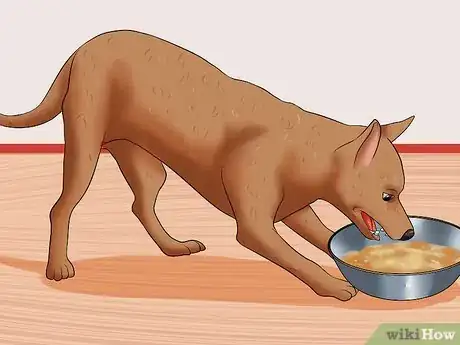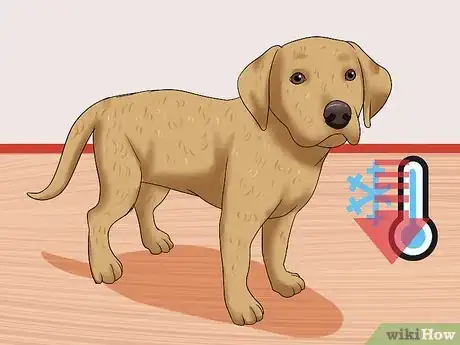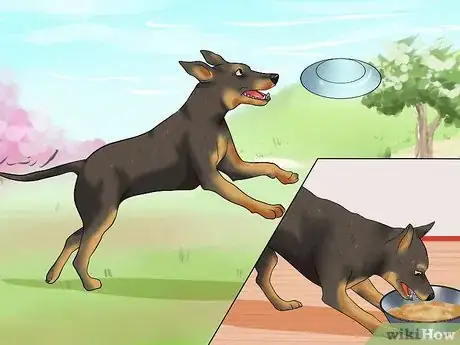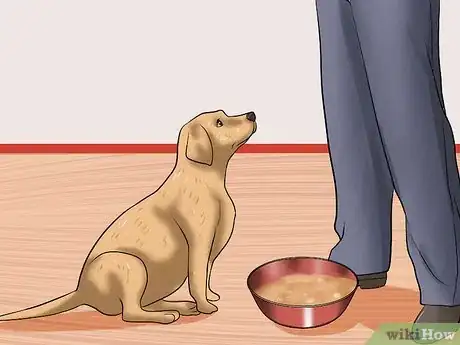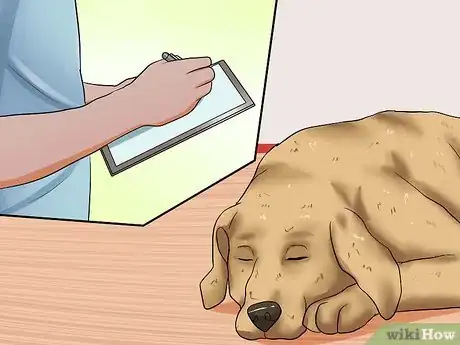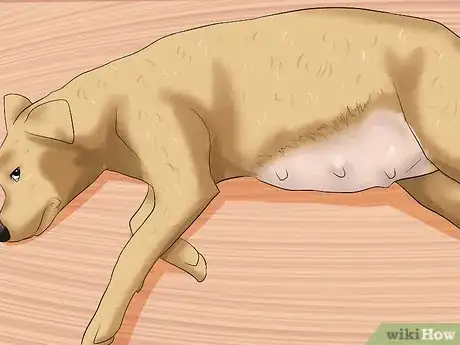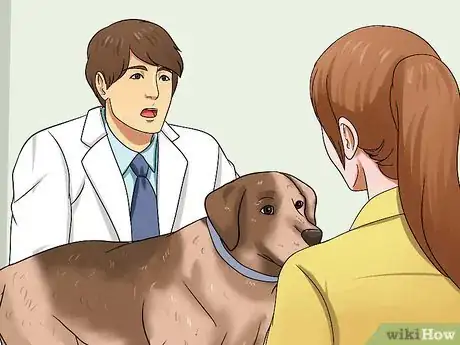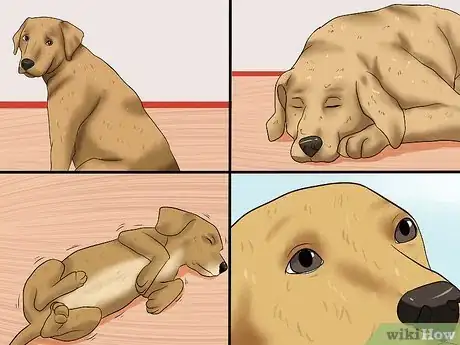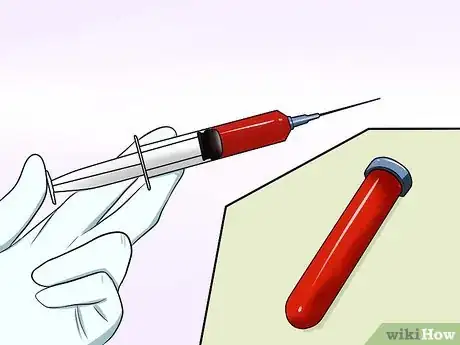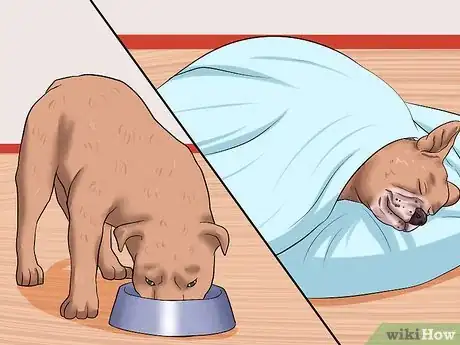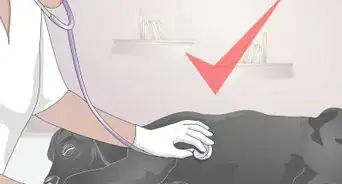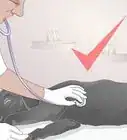This article was co-authored by Natalie Punt, DVM. Dr. Natalie Punt is a Veterinarian and the Founder and CEO of mPet- a smart phone app for pet owners to store, manage and transfer their pets medical records and health information. She specializes in small animal emergency and general medicine and veterinary practice economics. Dr. Punt holds a BS in Biochemistry and Molecular Biology from The University of California, Davis, an MS in Biochemistry from The University at Buffalo, and a DVM from Western University of Health Sciences.
There are 7 references cited in this article, which can be found at the bottom of the page.
wikiHow marks an article as reader-approved once it receives enough positive feedback. In this case, several readers have written to tell us that this article was helpful to them, earning it our reader-approved status.
This article has been viewed 27,274 times.
Blood sugar acts as the main energy source for your dog, and hypoglycemia is a condition where your dog has low blood sugar levels. This can occur when a diabetic dog is given too much insulin, or the dog has a health problem, or your dog needs to eat more. If your dog's blood sugar drops, it can cause lethargy and even loss of consciousness. Learn how to prevent this condition to protect your dog.
Steps
Preventing Hypoglycemia
-
1Feed small dogs often. Toy breeds and puppies require more glucose than larger dogs, so they are more susceptible to hypoglycemia. To avoid this, feed your small dog often. Feed your dog a meal high in quality protein[1] , high in fat, with complex carbs, like white rice.[2]
- Make sure to keep small dogs warm if they are underweight or don’t eat.
-
2Limit stress for puppies. Puppies under three months old can get hypoglycemia because they haven’t developed enough to regulate their blood sugar. Because of this, stress can bring on hypoglycemia. Limit stressors, such as poor nutrition, cold environments, and intestinal parasites.[3]Advertisement
-
3Feed your dog more before high levels of activity. If your dog is going to be engaging in high levels of activity, such as hunting, then you need to feed him beforehand. Give him food a few hours before the activity. The food should be high in protein and fat.
- Intense exercise when a dog hasn’t eaten can cause hypoglycemia.
- Don't strenuously exercise a dog who has just eaten a meal, as this can cause bloating. Wait at least 90 minutes after feeding before exercising your dog.
-
4Monitor dogs with conditions related to hypoglycemia. Hypoglycemia is associated with certain conditions. If your dog has diabetes mellitus, she may develop hypoglycemia if she does not eat and is then given a dose of insulin, or is given too large a dose of insulin. Dogs with Addison’s disease, severe liver disease, pancreatic tumors, or portosystemic shunts are also at risk.[4] If your dog has any of these conditions, then make sure to monitor her energy levels and make sure she eats often enough, and eats the right kind of foods.
-
5Monitor dogs with diabetes. Dogs who have diabetes could end up with hypoglycemia if given too much insulin. It is more likely if the dog isn't eating well, if the dog skips a meal, if the dog vomits, or if amount of food changes.[5]
- If your dog gets daily insulin, make sure the same person does it every day. This can cut down on double doses. Giving a dog too much insulin can result in death.[6]
- Make a food and activity log for your dog to make sure he is getting consistent levels of food and activity.
-
6Watch pregnant dogs carefully. Pregnancy can cause blood sugar irregularities. If you have a pregnant dog, monitor her food intake and energy levels.[7]
-
7Take your dog to the vet. If your dog gets hypoglycemia because he is not eating, you should want to find out why. Your vet can figure out if there is an underlying condition. There may be other factors that cause hypoglycemia, which can also cause problems and need to be checked by the vet.
Understanding Hypoglycemia
-
1Know the symptoms. There are many symptoms of hypoglycemia. These symptoms include:[8]
- Loss of appetite
- Increased hunger
- Blurred vision
- Confusion
- Lack of energy
- Loss of consciousness
- Anxiety
- Shivering
- Heart palpitations
- Seizures
-
2
-
3Treat hypoglycemia. You can treat the hypoglycemia in a few ways. You can give the dog food and find a way to keep him warm. If the dog won’t eat, try giving him some honey, syrup, or glucose gel. You can rub the sweetener on the dog’s gums if he won’t swallow.
- If your small dog is refusing to eat and shows signs of low blood sugar, you can give him glucose.
Expert Q&A
-
QuestionWhat are some negative impacts of a low blood glucose level?
 Natalie Punt, DVMDr. Natalie Punt is a Veterinarian and the Founder and CEO of mPet- a smart phone app for pet owners to store, manage and transfer their pets medical records and health information. She specializes in small animal emergency and general medicine and veterinary practice economics. Dr. Punt holds a BS in Biochemistry and Molecular Biology from The University of California, Davis, an MS in Biochemistry from The University at Buffalo, and a DVM from Western University of Health Sciences.
Natalie Punt, DVMDr. Natalie Punt is a Veterinarian and the Founder and CEO of mPet- a smart phone app for pet owners to store, manage and transfer their pets medical records and health information. She specializes in small animal emergency and general medicine and veterinary practice economics. Dr. Punt holds a BS in Biochemistry and Molecular Biology from The University of California, Davis, an MS in Biochemistry from The University at Buffalo, and a DVM from Western University of Health Sciences.
Veterinarian If blood glucose levels drop too low (like in the 30s or so), the patient is at risk of developing seizures because there's not enough glucose to support normal brain function.
If blood glucose levels drop too low (like in the 30s or so), the patient is at risk of developing seizures because there's not enough glucose to support normal brain function. -
QuestionWhat are the signs of hyperglycemia in dogs?
 Natalie Punt, DVMDr. Natalie Punt is a Veterinarian and the Founder and CEO of mPet- a smart phone app for pet owners to store, manage and transfer their pets medical records and health information. She specializes in small animal emergency and general medicine and veterinary practice economics. Dr. Punt holds a BS in Biochemistry and Molecular Biology from The University of California, Davis, an MS in Biochemistry from The University at Buffalo, and a DVM from Western University of Health Sciences.
Natalie Punt, DVMDr. Natalie Punt is a Veterinarian and the Founder and CEO of mPet- a smart phone app for pet owners to store, manage and transfer their pets medical records and health information. She specializes in small animal emergency and general medicine and veterinary practice economics. Dr. Punt holds a BS in Biochemistry and Molecular Biology from The University of California, Davis, an MS in Biochemistry from The University at Buffalo, and a DVM from Western University of Health Sciences.
Veterinarian Common things you see in canine cases of hyperglycemia are increased thirst and urination. At the same time, they're also going to have weight loss because (depending on the case) their bodies are not able to utilize glucose as the primary fuel.
Common things you see in canine cases of hyperglycemia are increased thirst and urination. At the same time, they're also going to have weight loss because (depending on the case) their bodies are not able to utilize glucose as the primary fuel.
Expert Interview
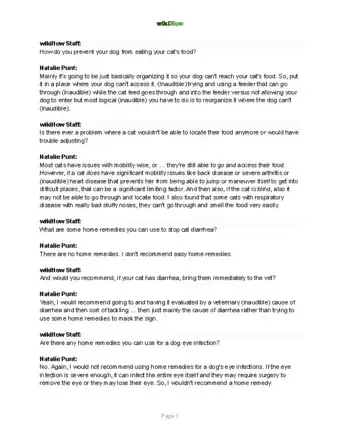
Thanks for reading our article! If you'd like to learn more about dogs' health, check out our in-depth interview with Natalie Punt, DVM.
References
- ↑ http://www.dogaware.com/articles/wdjdiabetes.html#hypoglycemia
- ↑ https://www.vetinfo.com/dhypogly.html
- ↑ http://www.pethealthnetwork.com/dog-health/dog-diseases-conditions-a-z/hypoglycemia-dogs
- ↑ http://www.pethealthnetwork.com/dog-health/dog-diseases-conditions-a-z/hypoglycemia-dogs
- ↑ http://www.vetstreet.com/our-pet-experts/preventing-and-handling-diabetic-emergencies
- ↑ http://www.whole-dog-journal.com/issues/15_5/features/Hypoglycemia_20520-1.html
- ↑ https://www.petcarerx.com/article/the-many-causes-of-hypoglycemia-in-dogs-and-cats/2738
- ↑ http://www.petmd.com/dog/conditions/endocrine/c_dg_low_blood_sugar
- ↑ http://www.pethealthnetwork.com/dog-health/dog-diseases-conditions-a-z/hypoglycemia-dogs
About This Article
To prevent hypoglycemia in your dog, make sure you feed it often enough to keep its blood sugar at a healthy level, and give it a diet high in protein, fat, and complex carbs. Small dogs should be fed more often because they require more glucose than larger dogs. You should also be sure to feed your dog more than usual if it is going to be engaging in high levels of activity. If your dog has diabetes, be sure to monitor its eating habits more closely, and make sure it gets the proper amount of insulin each day because skipping a dose can cause hypoglycemia. If your dog gets hypoglycemia because it isn’t eating, talk to your vet to find out if it has an underlying condition. For more tips from our Veterinary co-author, like how to recognize the symptoms of hypoglycemia, keep reading!
